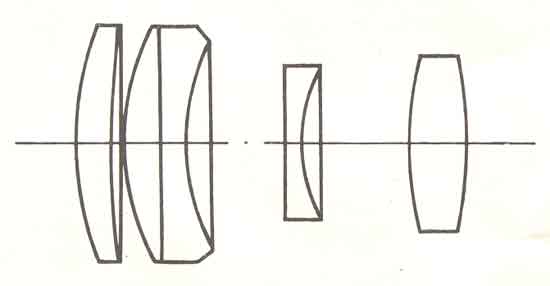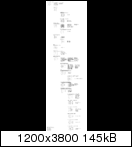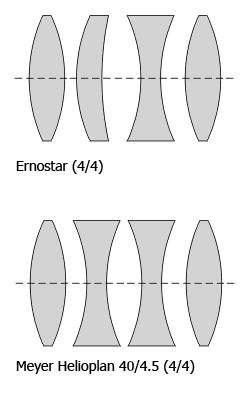| View previous topic :: View next topic |
| Author |
Message |
aoleg


Joined: 22 Feb 2008
Posts: 1387
Location: Berlin, DE
|
 Posted: Sun Dec 06, 2009 9:02 pm Post subject: Posted: Sun Dec 06, 2009 9:02 pm Post subject: |
 |
|
aoleg wrote:
| cooltouch wrote: |
| I suppose I should mention this: I've recently been going through some of my old collections of photo-related publications, and I have some items that members here might find interesting. |
I have never seen an optical diagram to Micro Nikkor 105/2.8 (Ai-S). Do you have one? 
_________________
List of lenses |
|
| Back to top |
|
 |
Seele

Joined: 17 Apr 2009
Posts: 742
Location: Sydney Australia
|
 Posted: Wed Dec 09, 2009 3:09 pm Post subject: Posted: Wed Dec 09, 2009 3:09 pm Post subject: |
 |
|
Seele wrote:
no-X,
I have been dipping in at this thread for a little while.
In his book "Optics", later "Photographic Optics", Arthur Cox had done a lot of work tracing the developments of each type of lens; I think it would be helpful to use his work as an additional reference.
You would be most welcomed if you want to consider my way of looking at it as another way of considering the various divergence in development. Here I'll have a go at the triplet:
Our foundation: the Cooke Triplet by Harold Dennis Taylor; first with the front two elements very close together, later the elements were arranged with a somewhat more balanced spacing.
First divergence: Aldis Uno Anastigmat: a reversion to its former configuration and taken to extreme, where the two front elements are cemented into a doublet, making for a 2:1 scheme.
Development method one: replacing each element with a cemented doublet:
Rear element replaced by a doublet: classic Tessar type, even though its genesis was a combination of an Unar front with a Protar back, making it 1-1:2.
Variation: placing the diaphragm behind the front element making it 1:1-2 as in Elmar.
I do not recall off-hand any lens with the front element replaced by a doublet.
Middle element replaced by a doublet: another type of Hektor.
Both front and back elements replaced by doublets:
Version 1: positive on the outside: Original Heliar.
Version 2: negative on the outside: Dynar, later renamed Heliar.
All three elements replaced by doublets: Hektor (and also the Dallmeyer Triple Achromatic designed way before the Cooke Triplet).
Development method two: replacing each element with a pair of lenses.
Front element replaced by a pair of lenses: Kern Kino-Objektiv.
Rear element replaced by a pair of lenses: Taylor-Hobson Speedic and Coric.
Middle element replaced by a pair of lenses: Taylor-Hobson Aviar. This makes the lens symmetrical and closer to the Double-Gauss type. In the Aviar the two negatives are placed very close to each side of the diaphragm, then the Dogmar type makes them pulled further apart.
I hope you follow my line of thought. |
|
| Back to top |
|
 |
francotirador


Joined: 17 Sep 2009
Posts: 894
|
 Posted: Thu Dec 10, 2009 3:23 am Post subject: Posted: Thu Dec 10, 2009 3:23 am Post subject: |
 |
|
francotirador wrote:
End of my doubts. Great job.
Thanks. 
_________________
Canon 5D II-Sony nex 6
Canon L 80-200 f 2.8 - Canon L 135 f2 - Canon FD 135/2.5 convert to EOS - Yashica 50 1.4 ML - Canon FD 50 1.2 - Distagon 35mm 2.8 T AEJ - Minolta MC 24mm f 2.8 - Canon LTM 85 1.9- Canon LTM 85mm 1.9 convert to EOS - Rodenstock Heligon 50 1.9 - Color Skopar 50 2.8 & MAte Box & filters 4X4
Contax RTS II y Minolta SRT 303 - 28-135 3.6 Tokina - Minolta MD 45 f2.0 - Minolta Zoom 80 200 4.5 (Leica)
www.isgleasphoto.com
The life is more easy with this forum .... |
|
| Back to top |
|
 |
no-X


Joined: 19 Jul 2008
Posts: 2495
Location: Budejky, Czech Republic
|
|
| Back to top |
|
 |
aoleg


Joined: 22 Feb 2008
Posts: 1387
Location: Berlin, DE
|
 Posted: Mon Jan 11, 2010 3:28 am Post subject: Posted: Mon Jan 11, 2010 3:28 am Post subject: |
 |
|
aoleg wrote:
Kaleinar-5N 100/2.8 (an Ernostar/Sonnar type):

_________________
List of lenses |
|
| Back to top |
|
 |
no-X


Joined: 19 Jul 2008
Posts: 2495
Location: Budejky, Czech Republic
|
 Posted: Mon Jan 11, 2010 11:04 am Post subject: Posted: Mon Jan 11, 2010 11:04 am Post subject: |
 |
|
no-X wrote:
This scheme looks a bit weird. It looks like 8/4, but it should be probably 5/4(?)
_________________
(almost) complete list of Helios lenses |
|
| Back to top |
|
 |
aoleg


Joined: 22 Feb 2008
Posts: 1387
Location: Berlin, DE
|
 Posted: Mon Jan 11, 2010 11:15 am Post subject: Posted: Mon Jan 11, 2010 11:15 am Post subject: |
 |
|
aoleg wrote:
| no-X wrote: |
| This scheme looks a bit weird. It looks like 8/4, but it should be probably 5/4(?) |
It's just a weird way to draw an optical scheme. I edited it to highlight the actual glass elements.

_________________
List of lenses |
|
| Back to top |
|
 |
ludoo


Joined: 18 Sep 2009
Posts: 1397
Location: Milan, Italy
Expire: 2011-12-05
|
 Posted: Mon Jan 11, 2010 11:22 am Post subject: Posted: Mon Jan 11, 2010 11:22 am Post subject: |
 |
|
ludoo wrote:
It would be interesting to also include fixed-lens cameras, a comparison between the fl Ultron, Solagon, Xenon etc. |
|
| Back to top |
|
 |
Spotmatic


Joined: 18 Aug 2008
Posts: 4045
Location: Netherlands
|
 Posted: Mon Jan 11, 2010 11:31 am Post subject: Posted: Mon Jan 11, 2010 11:31 am Post subject: |
 |
|
Spotmatic wrote:
Also, where can I find the Voigtlander 50mm f/2 Septon? (http://www.taunusreiter.de/Cameras/Bessa_RF_histo.html)
_________________
Peter - Moderator
Pentax K-5 + Pentax 645 + Canon 5D + Bessa RF 10,5cm Heliar, and a 'little' bag full of MF lenses. The lens list is * here *.
My fast 80s: Asahi-Kogaku Takumar 83mm f/1.9 - Super-Takumar 85mm f/1.9 - FA 77mm f/1.8 Limited - Cyclop 85/1.5 (Helios-40 innards) - Komura 80mm f/1.8 - Meyer Görlitz Primoplan 7,5cm 1:1.9 - Carl Zeiss Jena 80mm f/1.8 Pancolar - Canon 85mm f/1.8 S.S.C. - Canon 85mm f/1.2 S.S.C. Aspherical |
|
| Back to top |
|
 |
lantan
Joined: 18 Jan 2010
Posts: 3
|
 Posted: Mon Jan 18, 2010 1:56 am Post subject: Posted: Mon Jan 18, 2010 1:56 am Post subject: |
 |
|
lantan wrote:
it would be nice to see in the list also Olympus Zuiko lenses, and Minolta Manual Focus lenses... here is the source for Minolta's:
www.rokkor-x.narod.ru/user_manuals/rokkors_schems/ |
|
| Back to top |
|
 |
rawhead


Joined: 09 Feb 2009
Posts: 1525
Location: Boston, MA
Expire: 2014-04-29
|
 Posted: Mon Jan 18, 2010 2:05 am Post subject: Posted: Mon Jan 18, 2010 2:05 am Post subject: |
 |
|
rawhead wrote:
I guess my beloved Zuiko 50/1.2 is a 7e/6g double gauss?
http://www.mir.com.my/rb/photography/hardwares/classics/olympusom1n2/shared/zuiko/htmls/50mm1.htm
_________________
Sony α7R, Pentax 67II, Kiev-60, Hasselblad 203FE, 903SWC, Graflex Norita 66, Mamiya M645 1000s, Burke & James 8x10, Graflex Pacemaker Speed Graphic (4x5 and 3x4), Century Graphic (2x3), R.B. Graflex Seried D, Rolleiflex SL66E, Rolleiflex 2.8C Xenotar, Mamiya C330f, a few M42, six P6, three OM, four Hasselblad, two Pentax 67, two Mamiya 645, one Noritar, and a sprinkle of EF. Oh, and an Aero Ektar and Leica Noctilux |
|
| Back to top |
|
 |
lantan
Joined: 18 Jan 2010
Posts: 3
|
 Posted: Mon Jan 18, 2010 2:08 am Post subject: Posted: Mon Jan 18, 2010 2:08 am Post subject: |
 |
|
lantan wrote:
...some Exakta mount lenses schemes (Quinon,Westagon,Westanar,Quinar etc.) can be found in the "Exakta Unlimited" PDF manual here:
www.butkus.org/chinon/exakta/exakta_unlimited/exakta_unlimited.htm |
|
| Back to top |
|
 |
lantan
Joined: 18 Jan 2010
Posts: 3
|
 Posted: Mon Jan 18, 2010 2:20 am Post subject: Posted: Mon Jan 18, 2010 2:20 am Post subject: |
 |
|
lantan wrote:
Pentax Super Takumar 50/1.4 (early version, 8 elements, without thorium glass):
 |
|
| Back to top |
|
 |
taunusreiter

Joined: 20 Mar 2007
Posts: 127
|
 Posted: Wed Jan 20, 2010 2:45 pm Post subject: Posted: Wed Jan 20, 2010 2:45 pm Post subject: |
 |
|
taunusreiter wrote:
The first one is an enhanced triplet (added last lens).
The last one is mostly referenced as UNILITE type, a simplified Planar type.
 http://www.taunusreiter.de/Cameras/Wrayflex.html http://www.taunusreiter.de/Cameras/Wrayflex.html
The lens design overview is an excellent idea!
_________________
My flickr Gallery
My Classic Camera Website
Last edited by taunusreiter on Thu Jan 21, 2010 7:37 am; edited 3 times in total |
|
| Back to top |
|
 |
taunusreiter

Joined: 20 Mar 2007
Posts: 127
|
 Posted: Thu Jan 21, 2010 6:59 am Post subject: Posted: Thu Jan 21, 2010 6:59 am Post subject: |
 |
|
taunusreiter wrote:
| Relayer wrote: |
| its not UNILITE type. UNILITE have design 1-2 | 1-1, but Fujinon have 1-1 | 2-1 |
Oh, just the other way around.
We see the same at the Zeiss 100/2.8 Planar (MF; 6x9)

Is that lens good at f/1.6? A speed of f/2 is a bit critical with 5 element lenses, and f/1.6 sounds adventuresome.
_________________
My flickr Gallery
My Classic Camera Website |
|
| Back to top |
|
 |
no-X


Joined: 19 Jul 2008
Posts: 2495
Location: Budejky, Czech Republic
|
 Posted: Thu Jan 21, 2010 11:36 am Post subject: Posted: Thu Jan 21, 2010 11:36 am Post subject: |
 |
|
no-X wrote:
| lantan wrote: |
Pentax Super Takumar 50/1.4 (early version, 8 elements, without thorium glass):
 |
The lens scheme is already present in my current list of hybrid designs, but I just noticed I forgot to publish the last version of it... Thanks anyway 
Relayer: My target was to introduce just a few examples for every lens design. Not to include every single lens ever done... but I understand 
_________________
(almost) complete list of Helios lenses |
|
| Back to top |
|
 |
no-X


Joined: 19 Jul 2008
Posts: 2495
Location: Budejky, Czech Republic
|
 Posted: Thu Jan 21, 2010 12:37 pm Post subject: Posted: Thu Jan 21, 2010 12:37 pm Post subject: |
 |
|
no-X wrote:
| taunusreiter wrote: |
| Is that lens good at f/1.6? A speed of f/2 is a bit critical with 5 element lenses, and f/1.6 sounds adventuresome. |
I'd try, but I'm short of money at the moment. One 55/1.6 is available on ebay - and not too expensive:
Click here to see on Ebay
_________________
(almost) complete list of Helios lenses |
|
| Back to top |
|
 |
no-X


Joined: 19 Jul 2008
Posts: 2495
Location: Budejky, Czech Republic
|
 Posted: Thu Jan 21, 2010 10:23 pm Post subject: Posted: Thu Jan 21, 2010 10:23 pm Post subject: |
 |
|
no-X wrote:
Relayer: Done 
+ added some other designs: fujinon/unar, elmar, orthoscope, tair, hektor, telyt...
list of triplets, v.5:

PDF: high quality / optimized
_________________
(almost) complete list of Helios lenses |
|
| Back to top |
|
 |
Selenium_27

Joined: 12 Apr 2009
Posts: 118
Location: Strasbourg, France
|
 Posted: Mon Jan 25, 2010 5:31 pm Post subject: Posted: Mon Jan 25, 2010 5:31 pm Post subject: |
 |
|
Selenium_27 wrote:
First of all thanks for that imprssive informations collectrion.
I just found a picture, not from me, but from a selling siteof a truncated planar (1.8 50) for rollei. I thought it were relevant to post it there.

The seller argued it has been used in photokina. (but he ask a little bit too much, just for satisfying my curiosity : 300€)
I post here this for comparaison, taken from no-X file :
 |
|
| Back to top |
|
 |
no-X


Joined: 19 Jul 2008
Posts: 2495
Location: Budejky, Czech Republic
|
 Posted: Mon Jan 25, 2010 5:57 pm Post subject: Posted: Mon Jan 25, 2010 5:57 pm Post subject: |
 |
|
no-X wrote:
Selenium_27: The lens shown on your picture is the later Glatzels version (front element is convexo-concave). I used the earlier Tronniers version as example (front element concavo-convex). But it's really nice demonstration, thanks 
Anyway, I have one correction of a mistake in my list of triplets - related to Meyer Helioplan 40/4.5.
In the beginning of my research I found, that this lens is based on simple triplet. Later, when I bought one, I discovered, that the lens definately consists of 4 elements (not 3), so I pressumed, that the lens is Ernostar design. But now I discovered, that it isn't.
I prepared a drawing to make the difference visible:

The front surface of 2nd element isn't convex, but concave. That means, that the lens isn't typical Ernostar design. Honestly, I have no idea how to clasify it. It is a bit similar to simple 4-element double-gauss lens, but DG lens consists of postive and negative meniscus lenses - these are just simple biconvex and biconcave. On the other hand, now I understand, why Meyer called this design "double-anastigmat". It's a fully symetrical lens...
I'll correct this in the next version of our list.
_________________
(almost) complete list of Helios lenses |
|
| Back to top |
|
 |
francotirador


Joined: 17 Sep 2009
Posts: 894
|
 Posted: Thu Feb 04, 2010 4:08 am Post subject: Posted: Thu Feb 04, 2010 4:08 am Post subject: |
 |
|
francotirador wrote:
The Jupiter 21M - 200mm f4. That design is?
Thanks to all.
_________________
Canon 5D II-Sony nex 6
Canon L 80-200 f 2.8 - Canon L 135 f2 - Canon FD 135/2.5 convert to EOS - Yashica 50 1.4 ML - Canon FD 50 1.2 - Distagon 35mm 2.8 T AEJ - Minolta MC 24mm f 2.8 - Canon LTM 85 1.9- Canon LTM 85mm 1.9 convert to EOS - Rodenstock Heligon 50 1.9 - Color Skopar 50 2.8 & MAte Box & filters 4X4
Contax RTS II y Minolta SRT 303 - 28-135 3.6 Tokina - Minolta MD 45 f2.0 - Minolta Zoom 80 200 4.5 (Leica)
www.isgleasphoto.com
The life is more easy with this forum .... |
|
| Back to top |
|
 |
no-X


Joined: 19 Jul 2008
Posts: 2495
Location: Budejky, Czech Republic
|
 Posted: Thu Feb 04, 2010 7:50 am Post subject: Posted: Thu Feb 04, 2010 7:50 am Post subject: |
 |
|
no-X wrote:
Simplified Sonnar like Sonnars/Jupiters 135/3.5 + 135/4 (1-2 | 1). It's already present in next version I'm preparing 
_________________
(almost) complete list of Helios lenses |
|
| Back to top |
|
 |
francotirador


Joined: 17 Sep 2009
Posts: 894
|
 Posted: Thu Feb 04, 2010 2:00 pm Post subject: Posted: Thu Feb 04, 2010 2:00 pm Post subject: |
 |
|
francotirador wrote:
| no-X wrote: |
Simplified Sonnar like Sonnars/Jupiters 135/3.5 + 135/4 (1-2 | 1). It's already present in next version I'm preparing  |
Deservedly, the pictures of one and other are so similar
Many Thanks.
_________________
Canon 5D II-Sony nex 6
Canon L 80-200 f 2.8 - Canon L 135 f2 - Canon FD 135/2.5 convert to EOS - Yashica 50 1.4 ML - Canon FD 50 1.2 - Distagon 35mm 2.8 T AEJ - Minolta MC 24mm f 2.8 - Canon LTM 85 1.9- Canon LTM 85mm 1.9 convert to EOS - Rodenstock Heligon 50 1.9 - Color Skopar 50 2.8 & MAte Box & filters 4X4
Contax RTS II y Minolta SRT 303 - 28-135 3.6 Tokina - Minolta MD 45 f2.0 - Minolta Zoom 80 200 4.5 (Leica)
www.isgleasphoto.com
The life is more easy with this forum .... |
|
| Back to top |
|
 |
no-X


Joined: 19 Jul 2008
Posts: 2495
Location: Budejky, Czech Republic
|
 Posted: Wed Feb 10, 2010 5:02 pm Post subject: Posted: Wed Feb 10, 2010 5:02 pm Post subject: |
 |
|
no-X wrote:
I finaly found exact optical diagram of Primoplan 75/1.9. Maybe somebody sought it too...

_________________
(almost) complete list of Helios lenses |
|
| Back to top |
|
 |
cooltouch


Joined: 15 Jan 2009
Posts: 9096
Location: Houston, Texas
|
 Posted: Wed Feb 10, 2010 6:32 pm Post subject: Posted: Wed Feb 10, 2010 6:32 pm Post subject: |
 |
|
cooltouch wrote:
| aoleg wrote: |
| cooltouch wrote: |
| I suppose I should mention this: I've recently been going through some of my old collections of photo-related publications, and I have some items that members here might find interesting. |
I have never seen an optical diagram to Micro Nikkor 105/2.8 (Ai-S). Do you have one?  |
Sorry I didn't see this question before now. Yes, I have it. The 105mm f/2.8 Ai-S Micro-Nikkor from the 1985 edition of The Eyes of Nikon, p.152:

I just took a quick pic of the lens rather than scanning it. Good enough for this sort of thing, I guess.
_________________
Michael
My Gear List: http://michaelmcbroom.com/photo/gear.html
My Gallery: http://michaelmcbroom.com/gallery3/index.php/
My Flickr Page: https://www.flickr.com/photos/11308754@N08/albums
My Music: https://soundcloud.com/michaelmcbroom/albums
My Blog: http://michaelmcbroom.com/blogistan/ |
|
| Back to top |
|
 |
|
|
